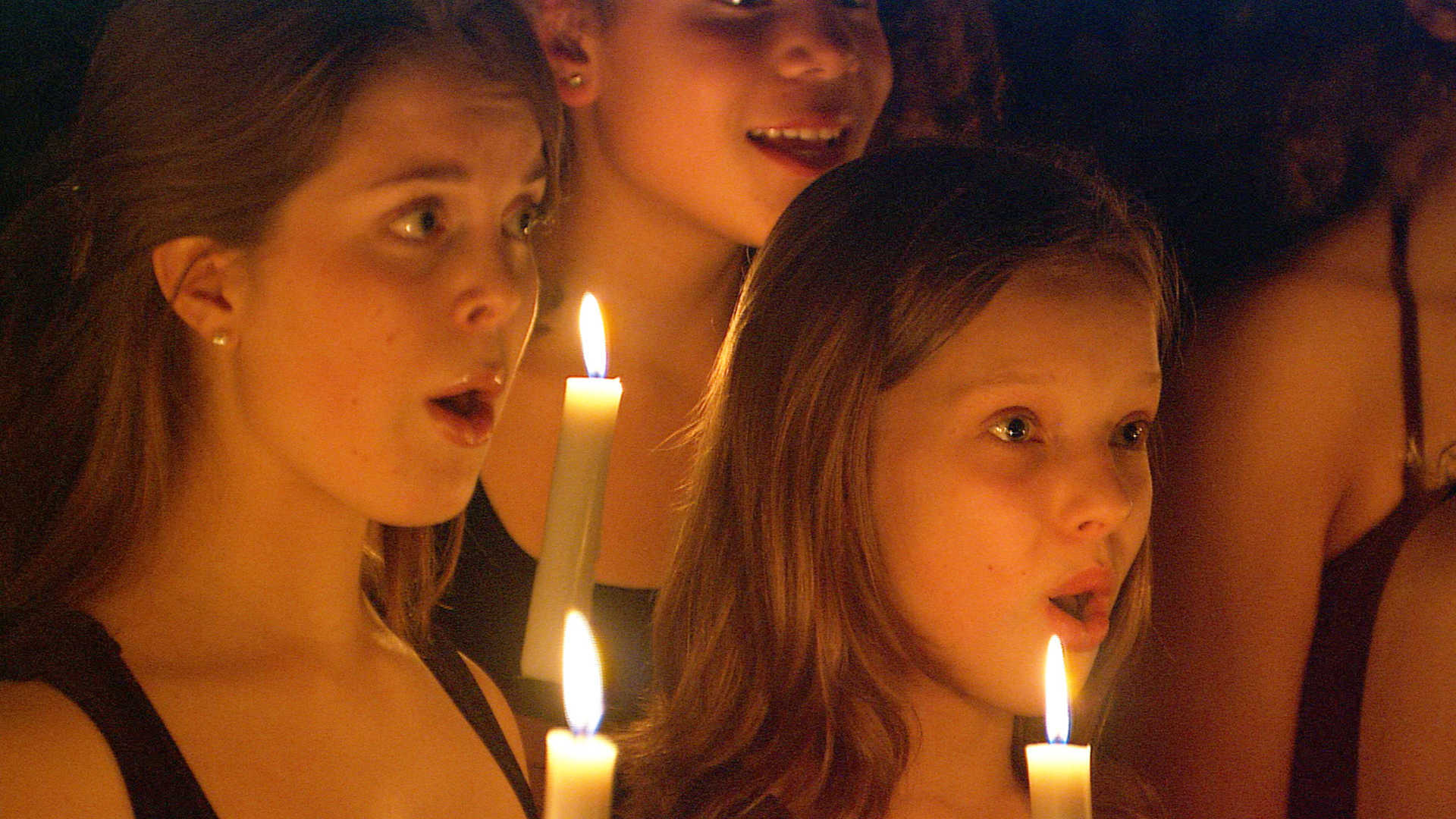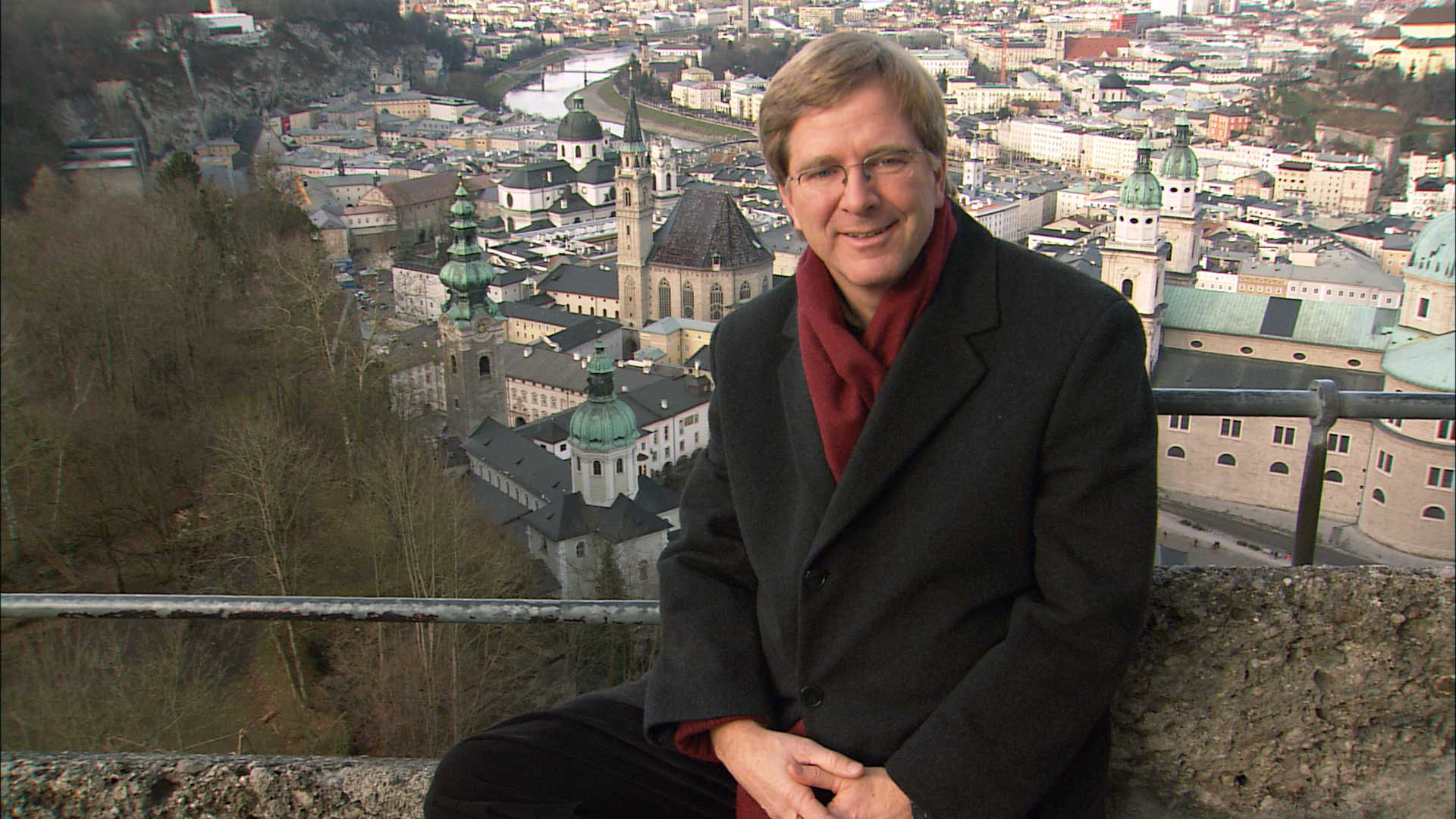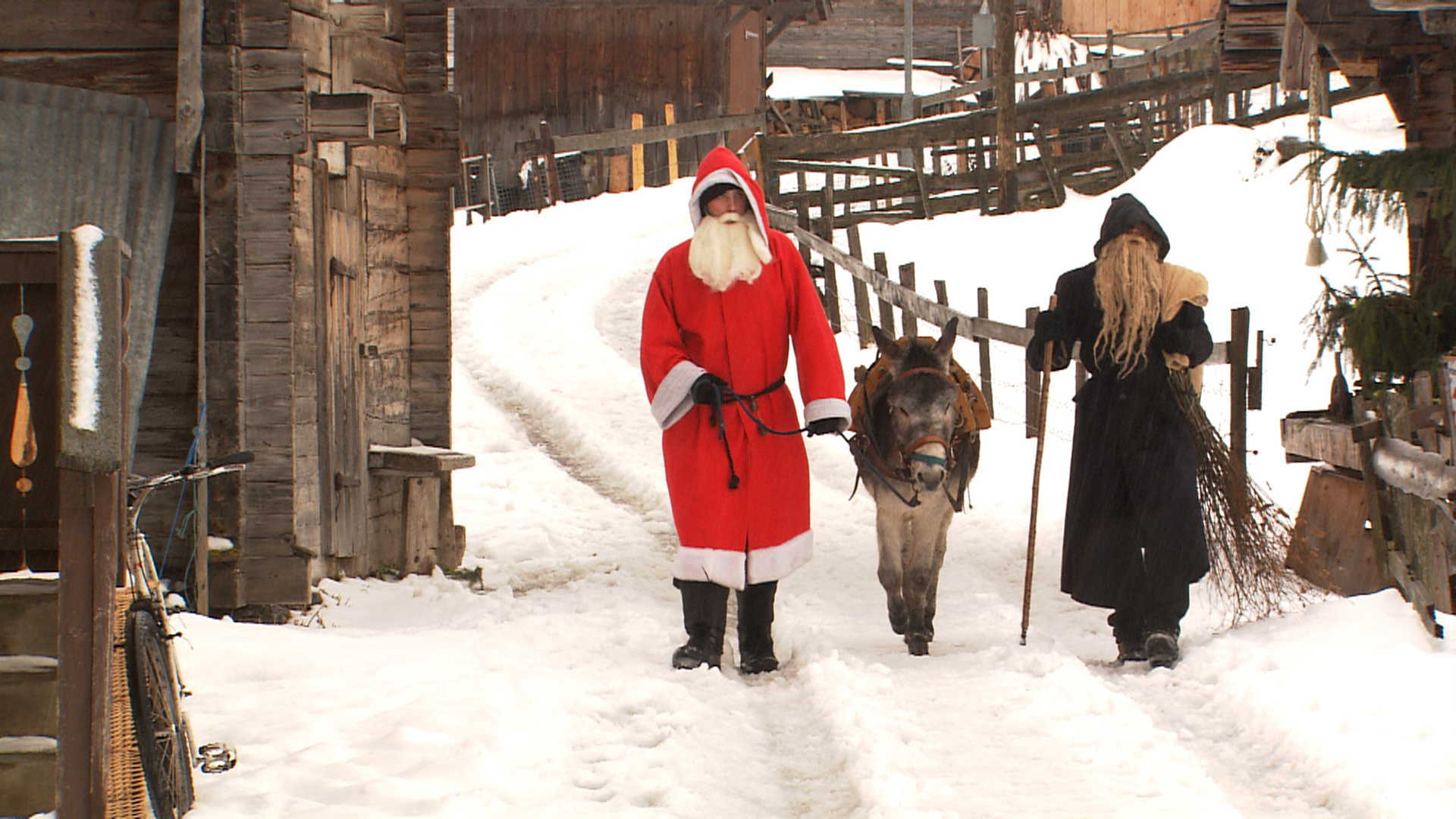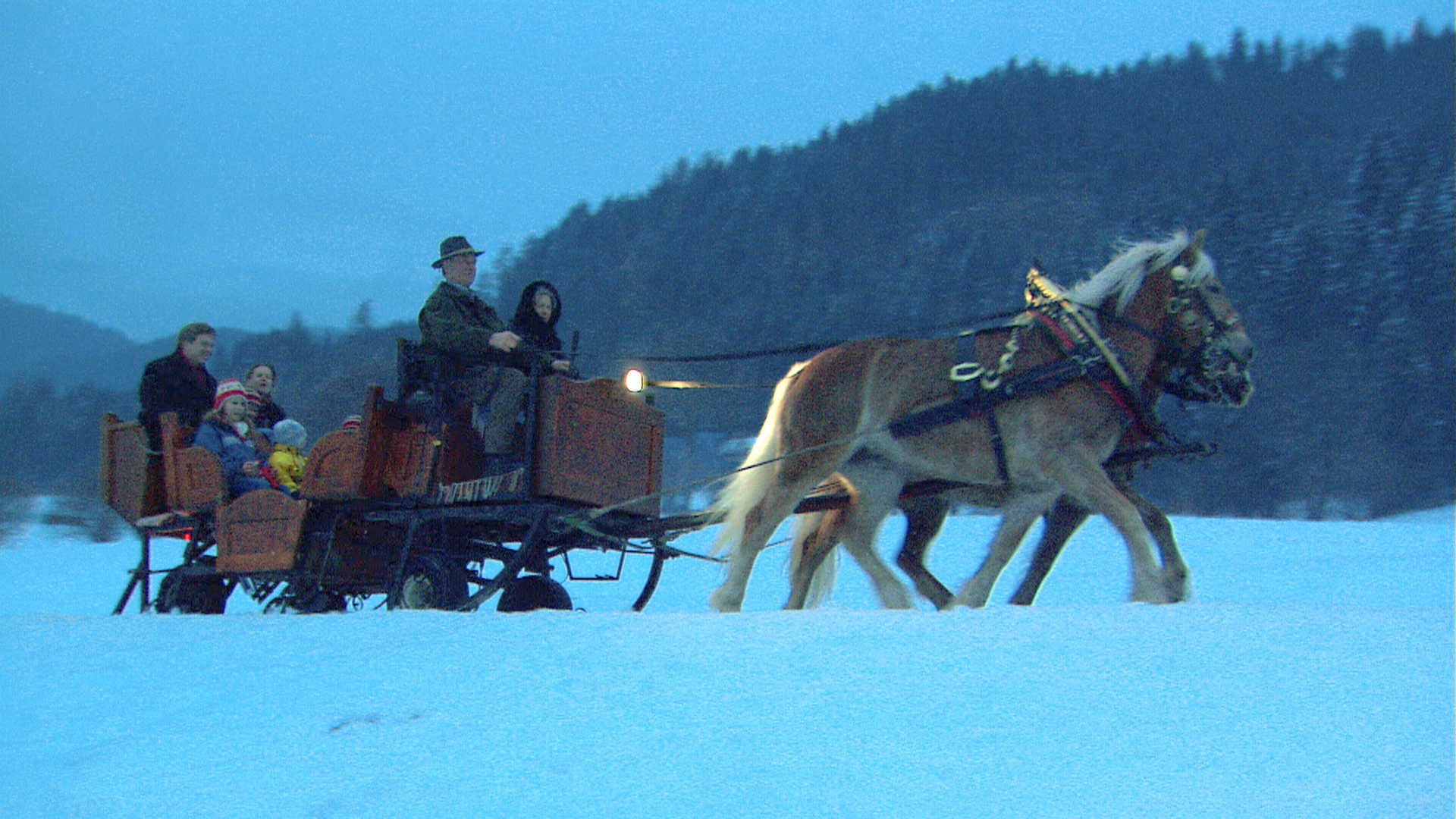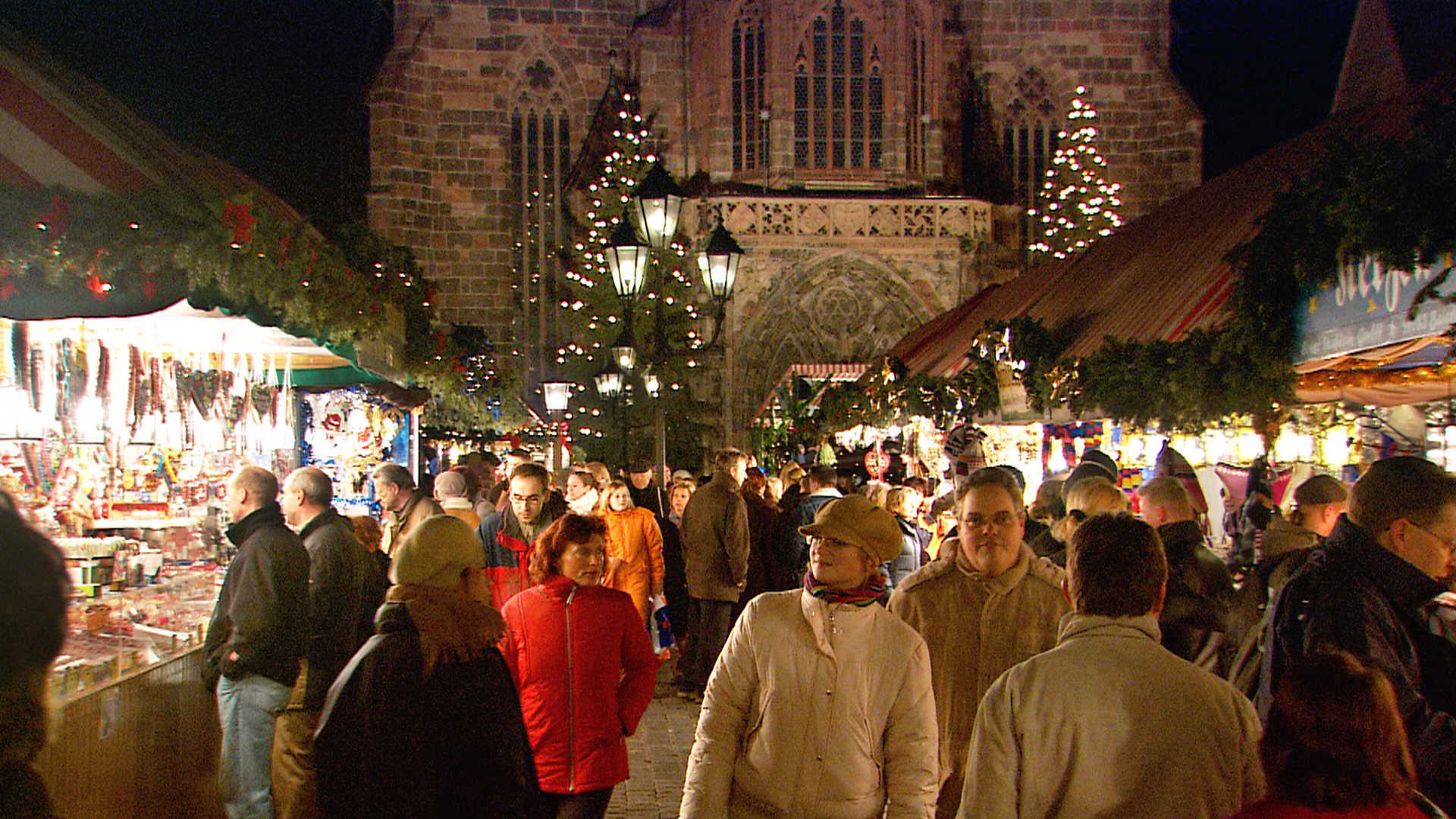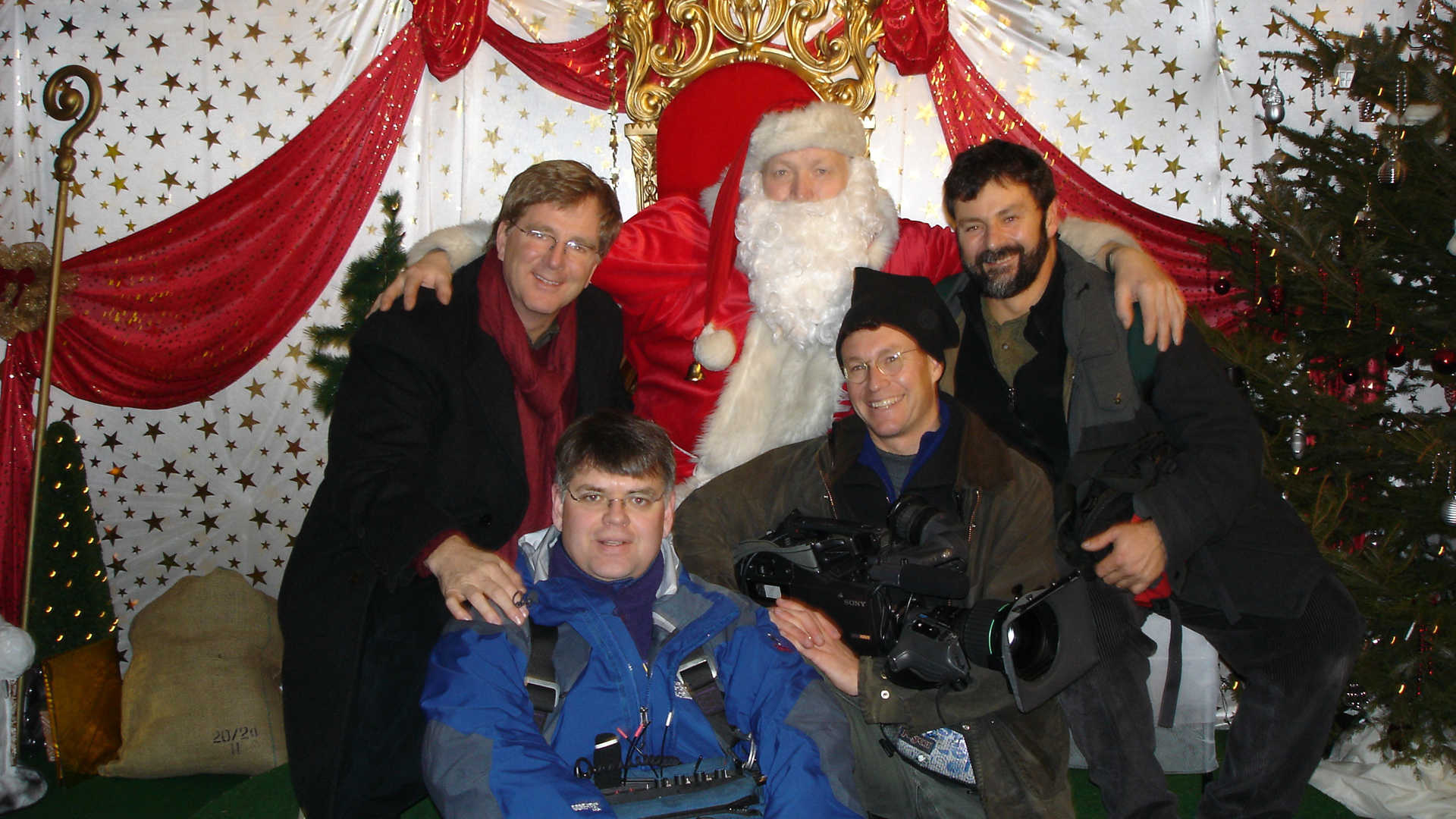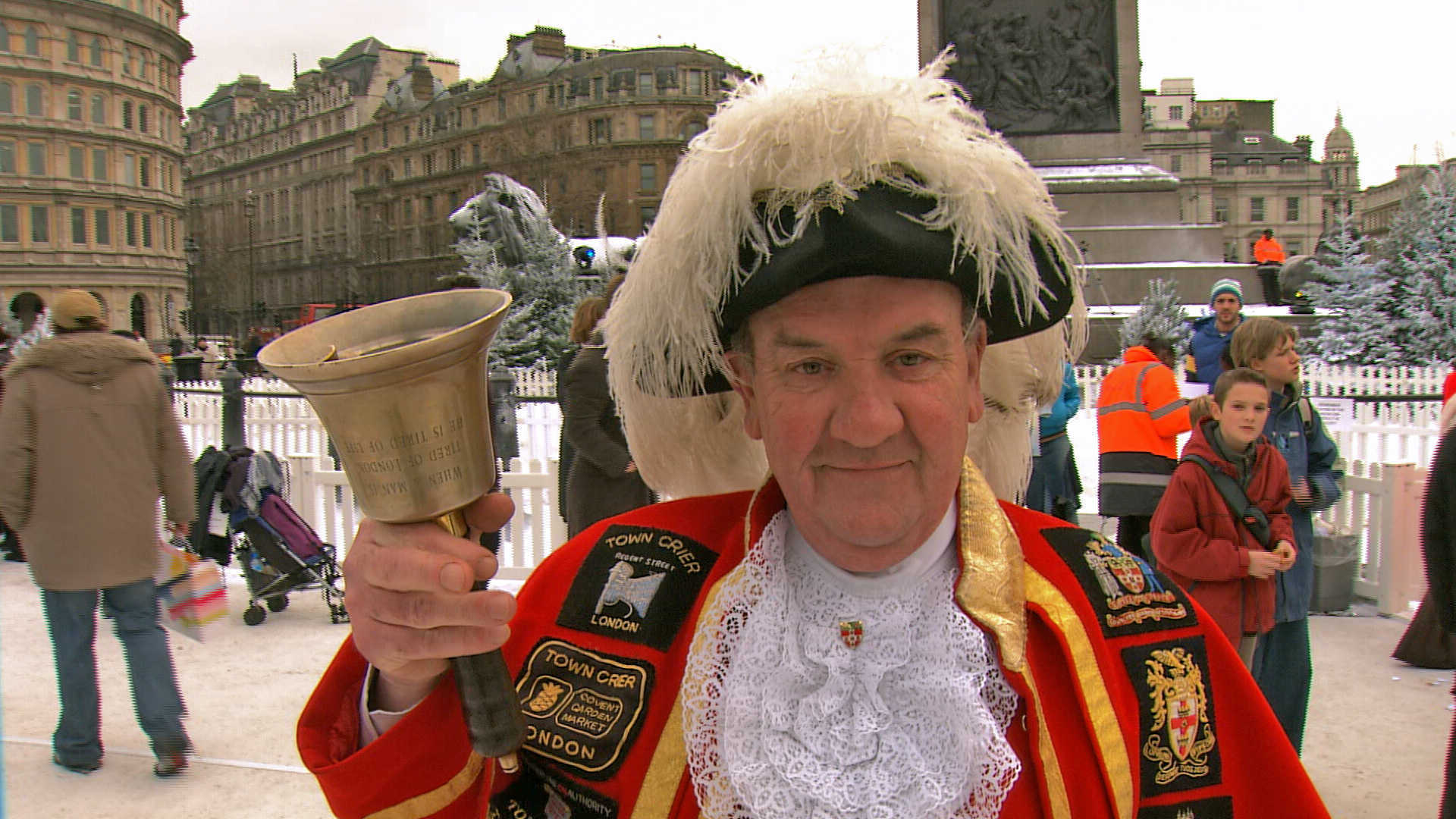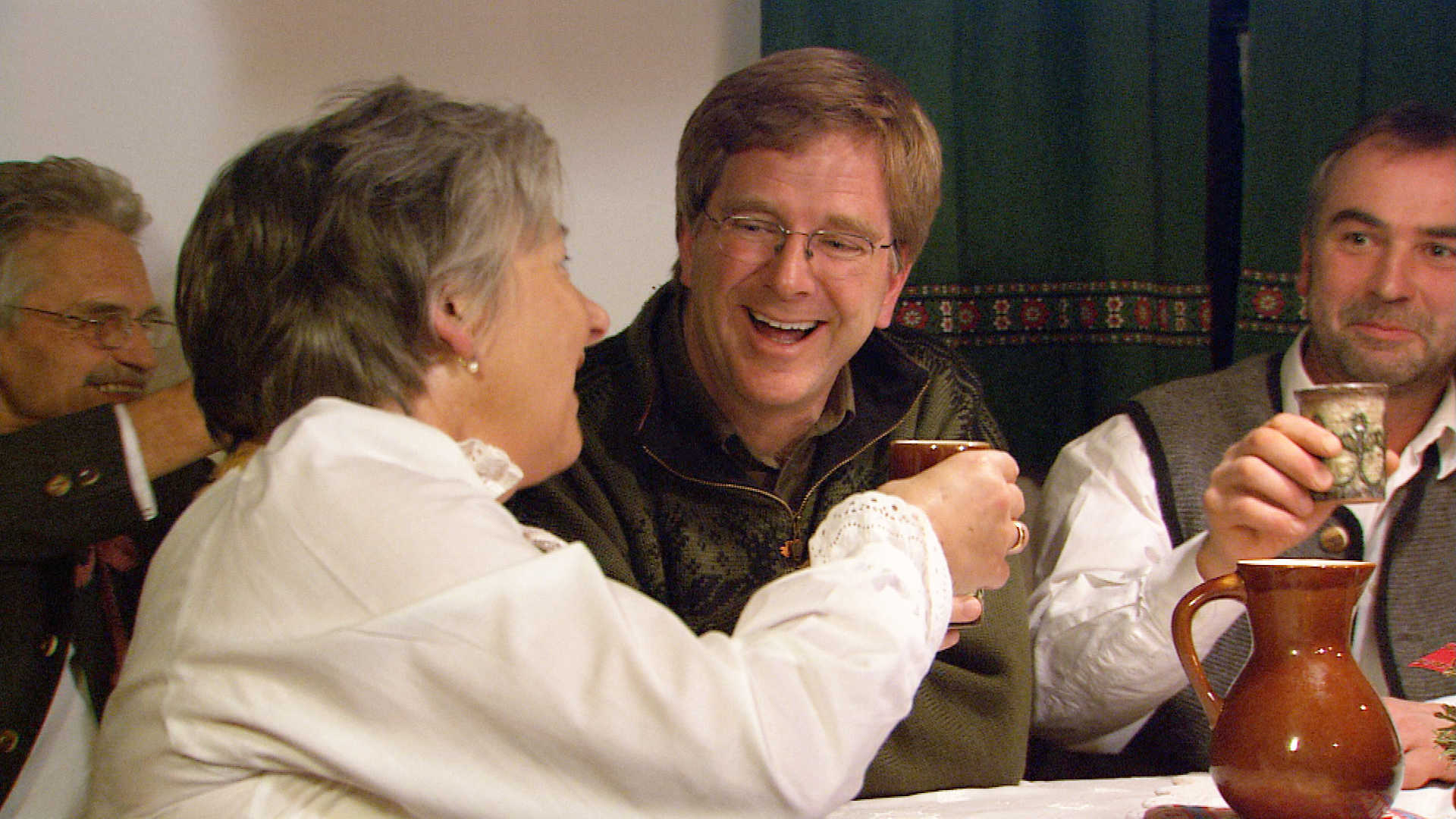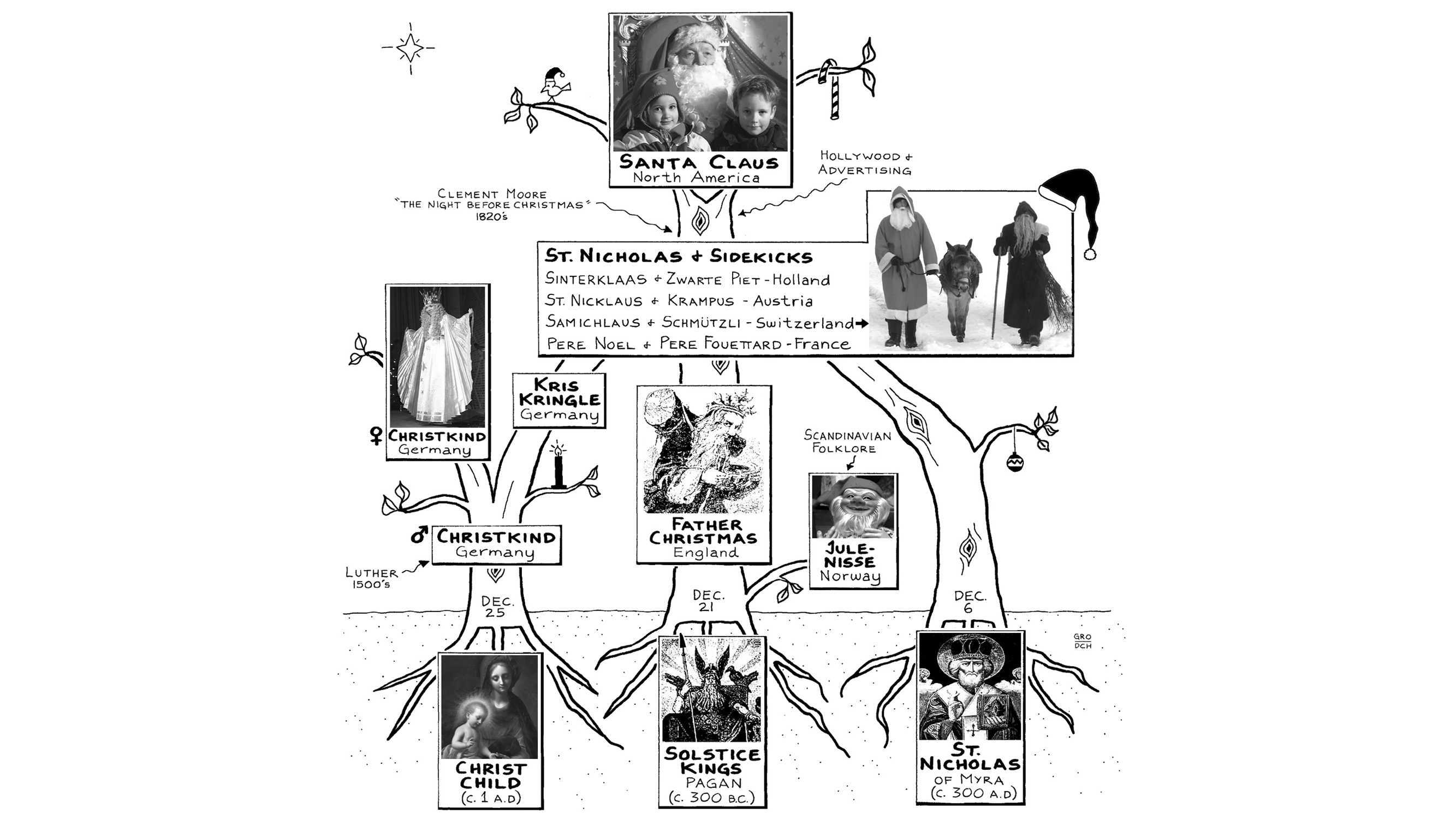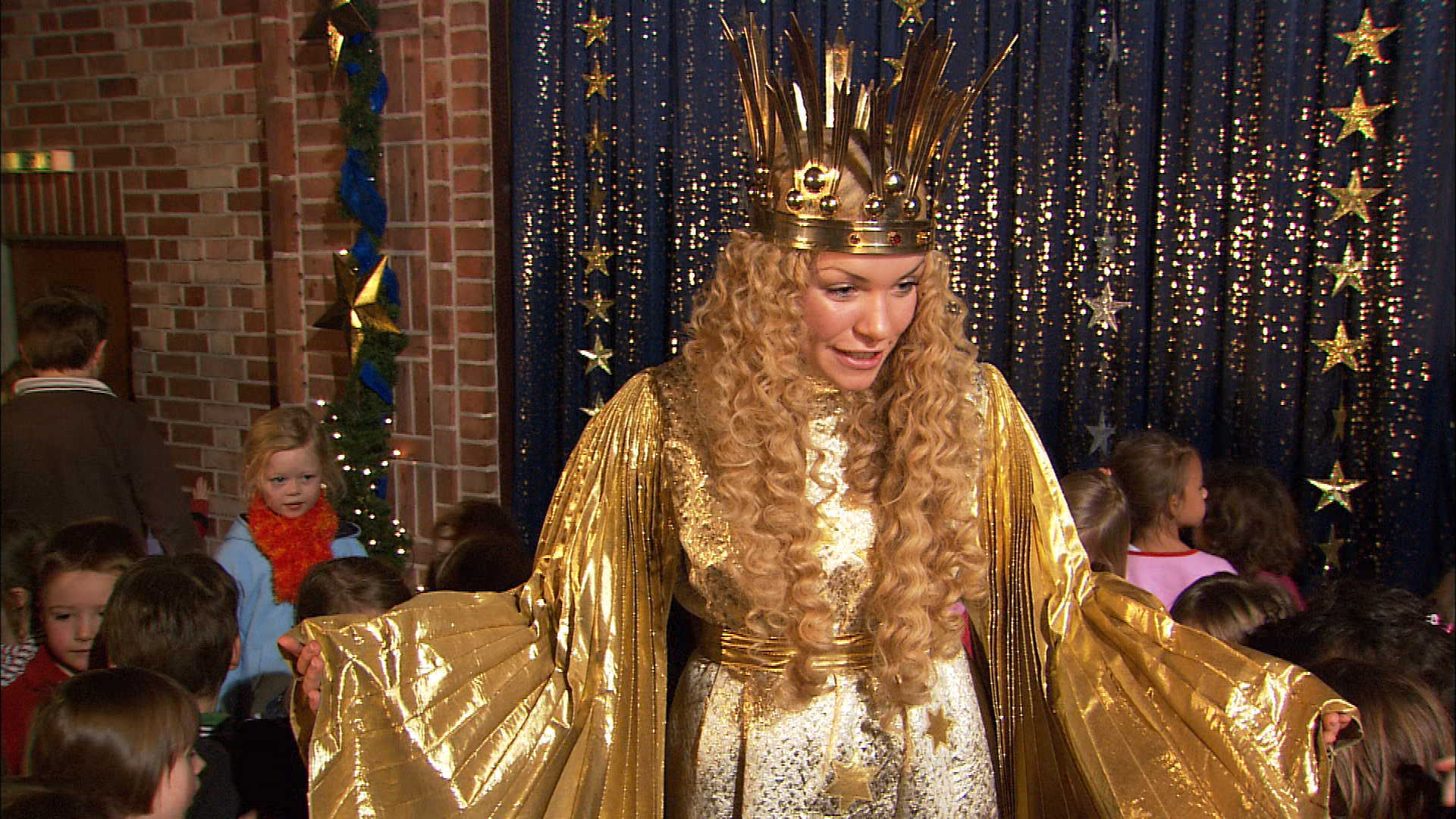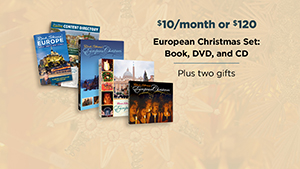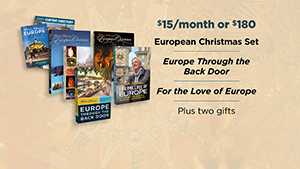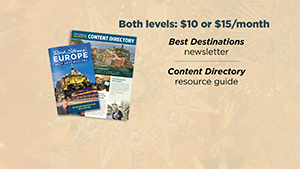European Christmas Special (and Pledge Event)
Join Rick Steves for a colorful, musical celebration of Christmas across Europe. From England to Wales, France, Norway, Germany, Austria, Switzerland, and Italy, you'll see the bright Christmas markets, hear local choirs, share holiday traditions with families…and even play in the snow.
Filming Christmas in Europe: The story behind the special
Length: 57 minutes. Pledge event length: approximately two hours, interspersed with fundraising breaks. Re-released 2015.
Promotional Tool Kit
Program Descriptions
RICK STEVES EUROPEAN CHRISTMAS
(RSMS, 1/60, TV-PG, Stereo, CC)
Re-release: 2015
Rick Steves' European Christmas [13 words]
Celebrate the rich, colorful, and fascinating mix of timeless Christmas traditions across Europe.
Rick Steves' European Christmas [58 words]
Join Rick for a colorful celebration of Christmas across Europe. This delightful montage of the holiday's rich traditions explores the sights and sounds of celebrations in Bath, Paris, Oslo, and Burgundy as well as the timeless traditions of Nürnberg, Salzburg, and Tuscany. We see the bright Christmas markets, share holiday traditions with families...and even play in the snow.
Rick Steves' European Christmas [77 words]
After producing more than 100 travel shows, Rick Steves and his television crew finally celebrate Christmas in Europe. The result — a picturesque celebration in Rick Steves' European Christmas, a co-production of Back Door Productions and PBS. This colorful montage of the holiday's rich history of traditions explores the sights and sounds of celebrations in Bath, Paris, Oslo, and Burgundy as well as the timeless traditions of Nürnberg, Salzburg and Tuscany in a European snapshot of Christmas.
Rick Steves' European Christmas [99 words]
From England to Norway, Burgundy to Bavaria, and Rome to the top of the Swiss Alps, Rick Steves' European Christmas gets you a seat at the family feast; saves you a pew up in the lofts with the finest choirs; and hands you a rolling pin in grandma's kitchen as she labors over her best-kept holiday secrets. You'll join Romans cooking up female eels, Parisians slurping oysters, Tuscans tossing fruit cakes, and Norwegian kids winning marzipan pigs. Exploring the rich and fascinating mix of traditions — Christian, pagan, commercial, and edible — you'll see Christmas in a new light.
Promotional Media
Click on the images to view the full-sized JPGs. Right-click on the download link to save the image.
Norwegian Girls Choir. Download image
Rick in Salzburg, Austria. Download image
Samichlaus and Schmutzli in the Swiss Alps. Download image
Sleighride at dusk in Tirol, Austria. Download image
Christmas market in Nürnberg, Germany. Download image
Rick and the crew with Santa. Download image
Town crier in Trafalgar Square in London. Download image
A holiday toast in Tirol, Austria. Download image
Santa's family tree. Download image
The Christkind in Nürnberg, Germany. Download image
Pledge Event: Premium Levels
Read a full description of the items by clicking to their product pages in our Travel Store.
Rick Steves' European Christmas – 2025
$120 Level or $10/month
- Rick Steves' European Christmas DVD
- Rick Steves' European Christmas book
- Rick Steves' European Christmas music CD
- Station Kit cost: $10.00
- Fair Market value: $34.97
- Item #: ZZ-CHRSET
$180 Level or $15/month
- Rick Steves' European Christmas DVD
- Rick Steves' European Christmas book
- Rick Steves' European Christmas music CD
- Rick Steves Forthe Love of Europe book
- Rick Steves Europe Through the Back Door book
- Station Kit cost: $30.00
- Fair market value: $88.95
- Item #: ZZ-CHRCOMBO
All Levels
- Rick Steves' Europe Content Directory: A comprehensive guide to all the free travel resources available on the Rick Steves' Europe website.
- No market value
- Item #: ZZ-CONTENT
- "Rick Steves' Best Destinations" travel newsletter: 64 pages of stories, color photos, and graphics of Rick's top itineraries in Europe.
- No market value
- Item #: ZZ-MAIL-NEWSLTR
Questions: [email protected]
To order, please contact:
[email protected]
Tel: 425-771-8303 ext. 240
Fax: 425-771-0833
Stations pay all shipping charges.
Pledge Event: Premium Images
Download composite JPEGs (below) of each pledge level, formatted for a 1920 x 1080 screen.
$120 Level: Download screen image
$180 Level: Download screen image
All Levels: Download screen image
Download a layered Photoshop file containing each pledge level as an editable group.
Download high resolution JPEGs of all pledge premiums for use in your own layouts.
Script
See the Travel Details above for recommendations highlighted in bold, excerpted from Rick's guidebooks.
Hi, I'm Rick Steves and it's Christmas time in Europe. From manger scenes to mistletoe from Norway to Rome…we're celebrating all over the Continent. Buon Natale! Fröhliche Weihnachten! Joyeaux Noël! Merry Christmas! And thanks for joining us.
In melting-pot America, Christmas is celebrated year after year with traditions that came over on the boat with our ancestors. In this holiday special we're traveling back to the old country — to places of rich variety and deep roots. We'll explore the history behind our much-loved traditions. Joining friends and families across Europe, we'll discover a Christmas that is both familiar and different.
England is filled with voices singing in the season. The short days around the solstice bring Norwegians out to celebrate the light of Christmas. Families, friends, and food are the center piece of the French Noël. An angelic Christmas presence fills Germany and Austria with magical wonder. Italy reveals the sacred nature of the season, from its countryside to its holiest shrines. Nature and all its wintry glory seems to shout out the joy of the season in Switzerland. And everywhere Christmas is celebrated with family, including my own, as together Europe remembers the quiet night that that holiest family came to be.
While each European culture gives Christmas its own special twist, they all follow the same story of how the son of God was born on earth — as told in the Bible and illustrated over the centuries by great artists.
The Christmas story begins with the Annunciation: an angel, sent from God with a message for a young woman, whose name was Mary. "And the angel said, 'Fear not, for thou shalt bring forth a son, and you will name him Jesus. And he shall be called the Son of the Most High and his kingdom will have no end.'
"And it came to pass, that there went out a decree from Caesar Augustus, that all the world should be taxed. And Joseph, a carpenter from Nazareth, went to Bethlehem to be taxed, with Mary who was expecting a child.
"And while they were there, she brought forth her firstborn son, and laid him in a manger, because there was no room in the inn.
"In that region there were shepherds, keeping watch over their flocks by night. An angel of the Lord came to them, and said, 'Fear not, for behold, I bring you good tidings of great joy. For unto you is born on this day in the city of David, a Savior, who is Christ the Lord.'
"And suddenly there was a multitude of angels proclaiming: 'Glory to God in the highest, and on earth peace and good will to all.'
"And the shepherds said, 'Let us go to Bethlehem,' where they found Mary, and Joseph, and the babe lying in a manger.
"Now after Jesus was born, there also came Wise Men. And a glorious star, which they saw in the east, went before them. Guiding them, it stood over where the child was.
"The wise men knelt down and worshipped the child, giving him gifts — gold, frankincense, and myrrh."
The long-awaited Messiah had arrived.
This is the story that Christians have celebrated through the ages. We don't really know on which day Jesus was born. Historians argue it was likely in spring, since shepherds were "tending their flocks." But, in the fourth century a pope declared December 25 to be the official birthday of Jesus. Why that day? Christianity was newly legal in the Roman Empire and the clever pope figured it would be smart if the biggest Christian festival coincided with the biggest pagan one — winter solstice. And throughout the land, people — Christians celebrating the birth of the son and pagans celebrating the return of the sun — have been rejoicing ever since.
For scenes straight out of a box of old-fashioned Christmas cards, we head to England — to the city of Bath. Here, in the heart of the old town near the magnificent medieval abbey, Bath hosts an annual Christmas market.
Carols are a deeply ingrained part of the English Christmas tradition. The custom goes back to Shakespeare's day. Today, young and old sing their way through the season.
Here the Bath Abbey Choir of Boys and Men are performing a carol concert by candlelight.
As is the case just about anywhere, it's in the countryside that families celebrate Christmas in the most down-to-earth style.
My friends Maddy and Paul and their kids, Theo and Leila, are looking for a living tree, which they'll decorate and then plant at home.
Maddy: About the right size?
Paul: A fairy on top?
Maddy: Brilliant. I like it.
It's a new twist on an old tradition — with a wink to the nature-worshiping pagans who once haunted these parts.
Decorating with greens goes back to the Druids who adorned their temples with swags of evergreen. For pagans, living greens — in the dead of winter — represented the persistence of life. And for Christians, evergreens are a reminder of the gift of everlasting life.
During the hectic season, getting together to bake Christmas goodies, while the little ones decorate edible ornaments, is a fine way for busy mums to spend some time together.
Maddy's recipe for mince pies harkens back to the days of Henry the 8th. Back then, the dried fruits, spices, and shredded meat for the filling were so expensive that only the wealthy could afford to make a mince pie. According to tradition, 12 pies should be eaten during the twelve days of Christmas to ensure good luck each month of the coming year.
Mother: Don't forget the mince pies, Maddy.
But it's the Christmas pudding that's the real centerpiece of a traditional English holiday meal.
Mother: This is Christmas pudding and it's made with lots of very special ingredients that in days gone by, they used to be very, very expensive. And it used to be called figgy pudding because it had lots of figs and things in it. It used to be made in Elizabethan times and we all have, because it's so special, an extra big stir and an extra big wish.
Kids: Figgy pudding song…
Theo: Now, we'll put this one up here…
Like a lot of us, Maddy and Paul are opting for a simpler, less commercial style of Christmas and that's reflected in their family traditions.
Little Theos and Leilas wouldn't always have been so involved in the family activities. Childhood as we know it really began in 19th-century England with the new middle class. And at Christmas those stern Victorians gave themselves permission to indulge their kids.
The English tradition of caroling starts very young. We're visiting Theo's school as the students take center-stage at the 14th-century village church for a very special Christmas concert.
Christmas is drawing near and tonight these lucky kids are taking a train through the woods to meet Santa, or as the English know him, Father Christmas.
Santa: Come on in now. Come on in and stand just there…and you stand just there…you come across there…that's right…and tell me your name…What's your name?
Boy: Dylan.
Santa: Hello, and what's your name?
Girl: Kate.
Santa: And what's your name?
Boy: Jack.
Santa: Oh, well done! Now, then most important, what do you want for Christmas?
Girls: I don't know.
Santa: Just some surprises? I'm very good at surprises. And what do you want?
Boy: Well, I haven't' got my list done yet.
Santa: Haven't you? I'm going to wait for your list and when it comes, I'll be ready for it. Now, are you going to do something for me? Are you going to leave something out for me on Christmas Eve?
Boy: Yes!
Santa: What are you going to leave me?
Boy: Mince pies and wine.
Santa: Well done! And are you going to leave a carrot for the reindeer?
Kids: Yes!
Santa: Well done.
We'll check back with Theo and Leila on Christmas Eve.
Santa: I've got something special for you...and what was your name?
Girl: Kate…
While children on their best behavior ask Santa for the toy of their dreams, my wish right now is a chance to hear one of finest chamber choirs in England, The Sixteen, filling a church with timeless sounds of the season.
Leaving the tranquility of the English countryside behind, London offers Christmas fun fit for a queen and streets twinkling with joy.
There's magic in the air…or…is that snow? Here in Trafalgar Square, in the heart of the city a winter wonderland has been created just for the day.
Father Christmas: It's a lovely snowy day, isn't it?
Father Christmas has dropped by for the wintry fun and London's Town Crier is in fine spirits as he passes out mince pies and holiday cheer.
Nearby at Somerset House, once a grand palace, the courtyard has been transformed into an ice skating rink elegant enough to make a commoner feel like royalty.
At Covent Garden shoppers can find classic toys for tots at Benjamin Pollock's famous toy shop, in business since the 1880s.
The joy and peace of the Christmas season bring both people and countries together. This giant spruce, a gift from the citizens of Oslo is a reminder of the friendship forged between Britain and Norway during World War II.
And Norway is where we're headed next.
Here in small town Norway, Christmas is celebrated with a unique intimacy and a Scandinavian flair for community. We're in Drobak, about an hour south of Oslo.
While its Norway's self-proclaimed capital of Christmas, Drobak feels like any idyllic town on a fjord.
It's Santa Lucia Day…December 13 — one of the darkest days of winter — and an important part of the Scandinavian Christmas season. All over Nordic Europe little candle bearing Santa Lucias are bringing light to the middle of winter and the promise of the return of summer. These processions are led by a young Lucia wearing a crown of lights.
This home has housed widows and seniors for over 200 years and today the kindergartners are bringing on the light in more ways than one.
The children have baked the traditional Santa Lucia saffron buns — the same ones these seniors baked when they were kindergartners.
Taking their cue from Santa Lucia, Norwegians — cozy in their homes — brighten their long dark winters with lots of candles, white lights — you'll never see a colored one — and lots of greenery.
In Norway, as in the rest of Europe, pagan symbols — like the evergreen tree — survive disguised as familiar Christmas traditions. The same is true of this sprig of mistletoe. In Scandinavia, it's associated with the Viking goddess of love. For Celtic people, it was a sacred plant. They used it to heal the sick and enhance fertility.
For most of us, it's just a handy excuse to steal a little Christmas kiss.
The Norwegian spirit of Christmas extends even to the departed. Candles flicker in grave yards as families remember lost loved ones.
And all over Norway, communities gather together in churches just like this as choirs cap Santa Lucia day with a concert.
And as the congregation follows the Santa Lucias out — more light of Christmas spills into this little fjord-side community.
Christmases everywhere come with special meals. Here in Norway, families treat children to a rice porridge…and it comes with a hidden almond…
The child who discovers it wins a…marzipan pig. It's reminiscent of the old days when a peasant family's wealth was tied up in its precious pig.
Juleøl, or Christmas beer, also goes back to medieval times when the Vikings liked to celebrate the winter solstice with a particularly stout brew.
And holiday desserts are a big part of Norway's Christmas season: the local Christmas fruitcake called Julekaca and a towering marzipan kransekake.
A common theme across cultures is a legendary gift giver — not always jolly and fat — who kids butter up with treats. While I grew up leaving Santa Claus milk and cookies by the fire place, kids here leave a bowl of porridge out by the barn…for the Julenisse.
These mischievous elves from the forest visit each Christmas not on reindeer…but with a horse, pig, and mouse entourage…and a bag of gifts. Every good child knows the Julenisse is coming with an exciting reward.
Just up the fjord, Norway's capital, Oslo, celebrates Christmas with a more urban charm. Streets are decorated, locals not ready to rely on the Julenisse are out shopping, and good cheer is abundant.
Christmas in Oslo feels low key. You'll feel it best not on the streets or in the malls, but in the homes, with friends…and in music.
Youthful voices fill the city's oldest church. The old Aker church, which dates back to the 12th century, hosts the Norwegian Girls Choir for an Advent concert.
We'll check back with the Santa Lucias and Julenisse later. And while Norway awaits the return of the sun, further south, Paris creates its own light.
Paris is nicknamed Europe's City of Light for its incandescent energy and effervescent culture. In the dark of winter, the city's best-loved icon, the Eiffel Tower, brilliantly heralds this happy season.
By night, Paris' biggest department stores dress up the streets. Printemps is pretty in pink — and the Galeries Lafayette has woven an exquisite embroidery of lights.
There's ice skating at the Hôtel de Ville.
And all along the Champs-Elysées, it's a festive forest of 2,000 twinkling trees.
By day, the signs of Christmas are more subtle but can be found everywhere. The best-dressed trees are seen here in the Pompidou Center. Where else but in Paris will you find avant garde Christmas trees…making a fashion statement.
With visions of Versace dancing in their heads, inspired fashionistas bundle up their wish lists and head to the designer boutiques on the Rue Royal.
Parisians buy fewer Christmas gifts than their American counterparts — its more a matter of quality than quantity — and they favor small specialty shops like these.
Christmas in Paris is elegantly understated — and the city yields unexpected moments. Turn a corner and you just might find yourself in a stylish arcade all wrapped up in red...
Busy Parisian shoppers fuel up on the city's street food: steamy crepes and hot roasted chestnuts.
Chestnut man: Joyeux Noël!
And neighborhood brasseries are full of friends slurping fresh oysters rushed in from the Brittany coast. Oysters are favorites at Christmas — which makes perfect sense as they're plump and delicious this time of year.
'Tis also the season of elegant edibles. Foie gras — a pâté made from goose liver and a smidge of cognac — is especially popular during holidays. And chocolate shops and patisseries — wonderful any time of the year — get even better at Christmas.
There are chocolate chestnuts, yummy Yule logs, and delights fit for a king.
This pâtisserie — the oldest in Paris — was opened in 1730 by an ex-pastry chef of the royal court.
Even sophisticated Paris rolls out the magic carpet for children. French families from all over the country rendezvous at the windows of the grand department stories. Displays are specially designed to enchant the little ones. And stools provided by thoughtful stores make sure that even the tiniest tot enjoys a good view.
During Christmas the Eiffel Tower becomes the highest ice skating rink in Paris, kids ride ponies at Luxembourg Gardens, and the city's magical manèges de Noël — the carousels of Christmas — spin memories.
A clear, cold day brings out Parisians, trying to soak up as much sunlight as possible on these, the shortest days of the year. While a dusting of snow brings out hopes for a white Christmas like at home. Whether you're young — or just young at heart, Christmas in Paris is the stuff of dreams.
If Paris is a gorgeous grand-dame strutting her Christmas finery, then Burgundy — where we're heading next — is her pious country cousin.
Burgundy lies in the quiet, religious heart of this mostly secular nation. France's most venerable abbeys are here and their spirit seems to animate the small villages throughout the region.
Ancient traditions survive comfortably here. This 13th-century abbey resonates with the rich sounds of the French group Phonema, singing medieval carols just as they were sung centuries ago.
A sense of community runs strong in rural France and it expresses itself in simple rituals shared by families and friends.
These old friends come here each winter to cut and gather wood for their fireplaces and stoves.
It's the kind of hard work that builds an appetite. Fortunately, they've brought drinks to cut the chill. With just enough red wine for the duck, there's bacon to sizzle, and potatoes to roast. Ahhh...c'est bon! A winter picnic in the woods is as good for the soul as it is for the stomach.
In Burgundy, no one goes without. Communities take good care of one another year 'round...with special treats at Christmas. This amiable village mayor, accompanied by her entourage, gets into the spirit of things by delivering baskets of delicacies to the elderly for the Christmas Eve feast.
This morning my friends the Berteloots are shopping for seasonal fare at the Saturday market. Fine food's at the center of life in Burgundy, even in the dead of winter. Right about now the truffles are at their pungent best. Delphine and Emmanuel prepare for the grandest culinary event of the year. The French call their Christmas Eve feast "La Réveillon de Noël."
At home the family's busy preparing for the big event. The children are decorating candles to set on the windowsill on Christmas Eve to light up the dark on that night so filled with anticipation.
And the tree's not quite done until capped with a star.
In the kitchen, Delphine slices her foie gras. Then devotes herself to the centerpiece of the Réveillon: filet of beef wrapped in brioche. Stretching the pastry is a two-person job. After generously grating local truffles...the beef is tenderly wrapped...and ready for the oven!
There's still the serious business of selecting the perfect wine from the cellar...
Soon guests will be arriving. This time of year, when days are short and nights are long, it's customary to leave a welcoming light in the window...
We'll be back when the dinner's ready. But first...we've got some shopping to do...in Germany. When it comes to traditional images of Christmas in Europe, Germany's Bavaria is the heartland. Here we'll savor classic holiday themes: glittering trees, old time carols, and colorful Christmas markets.
These markets — called Christkindl markets — enliven squares throughout Germany. The most famous is here in Nürnberg. It's a festive swirl of the heart-warming sights, sounds and smells of Christmas.
Long a center of toy making in Germany, a woody and traditional ambiance prevails. Nutcrackers are characters of authority — uniformed, strong-jawed and able to crack the tough nuts. Smokers — with their fragrant incense wafting — feature common folk like this village toy-maker. Prune people — with their fig body, walnut head, and prune limbs — are dolled up in Bavarian folk costumes.
And hovering above it all is the golden Rausch angel — an icon of Christmas in Nürnberg. "Rausch" is the sound of wind blowing through its wings. It's a favorite for capping family Christmas trees.
Bakeries crank out old fashioned gingerbread — the Lebkuchen Nürnberg — using the original 17th-century recipe.
Back then, Nürnberg was the gingerbread capital of the world and its love affair with gingerbread lives on.
Shoppers can also munch the famous Nürnberg bratwurst — skinny as your little finger—and sip hot-spiced wine.
As in so many cultures, kids love their local version of Santa Claus. While Santa is a legend, his character is based on St. Nicholas — a kind and generous bishop who actually lived in Turkey in the fourth century. Holiday gift giving — especially in Catholic regions — is often associated with the feast day of St. Nicholas, December 6.
But Germany is Luther country. Back in the early 1500s the Great Reformer, Martin Luther, wanted to humanize the Christmas story and get the focus away from saints and back on the birthday boy...Jesus. Rather than Jolly Old St. Nicolas bringing the goodies on December 6, Luther established the idea that gifts should be given on the 25th by the Christ child or, in German, the Christkind.
But for kids it was hard to imagine the little baby in the manger delivering gifts so an angel served as the gift-giving Christ child — and somehow the angel came to be represented by a young girl. She spends her reign spreading the joy of the season.
The Christkind concludes by telling the enthralled children, "If you're very, very gentle you can touch my wings."
Nürnberg's favorite angel then leads her fans into the children's section of the market: where expertly bundled kids enjoy a Christmas wonderland.
The Christkind isn't the only one handing out good cheer. Carolers spread the joy of Christmas using the town's historic courtyards as impromptu concert venues.
And here in the land of Bach, Beethoven, and Mozart, seasonal music fills the churches.
Now we cross the border into Austria to the town that to me always feels like Christmas...Salzburg.
With its old town gathered under its formidable castle, Salzburg celebrates the holidays with an Alpine elegance. Christmassy shopping lanes delight browsers. Markets are busy as shoppers gather last minute holiday decorations and perhaps a fresh sprig of mistletoe.
These Tirolians celebrate the season in noisier fashions as well. From the castle ramparts, high above town, traditional gunners fire away as they have since the days when they really believed these shots would scare away evil spirits.
Salzburg, nicknamed the "Rome of the north," has a magnificent cathedral — inspired by St. Peter's at the Vatican. Locals here in the town of Mozart pack the place to mix worship with glorious music at a Christmas mass.
It was here, in the region of Salzburg that the most loved carol of the Christmas season, Silent Night was first sung nearly two hundred years ago.
According to legend, a local priest went out one Christmas night to bless a newborn baby. As he walked home in the snow, he was so moved by the stillness of the starlit and holy night that he wrote a poem about it. He gave the poem to Franz Gruber, his church organist, who composed a simple tune. On Christmas Eve of 1818 the carol was sung for the first time...accompanied only by a guitar.
Austria is one of Europe's more traditional corners. Its strong Catholicism and a love of heritage shine especially brightly at Christmas time in the countryside.
We're visiting the Weissacher family farm. A typically Tirolian Christmas yodel offers us the warmest of welcomes...
This family is happy to share its love of the season with a guest.
Like just about anywhere — part of Christmas is making cookies with grandma.
More unique to Austria is the ritual in which the dad blesses the home with incense as his daughter follows with holy water. The prayer is for a healthy and happy new year.
Maria teaches her daughters how the Advent wreath marks the four weeks of Advent — the season of preparation leading to the advent or arrival of Jesus. Ancient peoples were the first wreathmakers. For Christians, that evergreen circle came to symbolize everlasting life. The candles, one for each week, reminded them that the birth of their savior was approaching.
Austrians lovingly decorate their tree...but keep it secret and hidden from the children...until December 24th arrives. We'll check back a little later to see what Christmas brings.
From here in the Alps we journey to the grand city which was the capital of the Western world on that first Christmas two thousand years ago and remains a leading city in Christendom today...
Rome. This is home of the Vatican City...headquarters of the Roman Catholic Church and some of Europe's most sacred Christmas traditions.
For centuries, pilgrims have hiked from all over Christendom to this great city. Domes and ancient obelisks still serve as markers lacing together relics and sacred stops, including the tomb of St. Peter — marked by the greatest dome anywhere.
And through the ages pilgrims have stopped here at the Basilica of Santa Maria Maggiore. The faithful believe the original planks from Jesus' crib are in this ornate container.
And here in the capital of Catholicism, each Christmas lovingly constructed manger scenes, called presepi, pop up all over town.
St. Francis of Assisi is credited with assembling the first nativity scene in 1223. He used it as a tool to teach people the story of the first Christmas. Sin the creative teaching style of St. Francis, manger scenes often put Bethlehem in a local context.
Instead of the Middle East, Italians have long set the Holy Family right here — in Italian settings. St. Francis knew that by putting Jesus in a place people would recognize — their own neighborhood — the faithful could relate more easily to the story of his birth.
And presepi range from the very traditional to the very surprising — like this one that imagines the nativity in an Eskimo village.
The ultimate manger scene is back on Rome's ultimate square — St. Peter's — where the pope celebrates Midnight Mass each Christmas Eve.
For Roman families there are more than just manger scenes to see. For centuries this lively square, Piazza Navona, has hosted a boisterous village-like holiday market that stays busy until Epiphany in January.
The Christmas season in Europe stretches for well over a month — not to stretch the shopping season but to fit in the season's holy days: Advent begins four Sundays before Christmas Eve. The Feast of St. Nicholas is on December 6, Santa Lucia day is the 13th. And Europeans don't wrap things up on December 25. The 12 days of Christmas go from the 25th to the 6th of January, Epiphany, the day the Three Kings finally delivered their gifts.
In Italy, on Epiphany, La Befana, a popular Christmas witch, flies over the rooftops filling children's stockings with candy or...coal.
Between visiting their manger scenes and Christmas witches, many Italians are shopping for their big Christmas Eve dinner. When it comes to a festa, Italians like to buy fresh and local...and lucky Romans enjoy an abundance of farmers' markets. La Vigilia, the traditional Christmas Eve dinner, calls for all the trimmings — here in Rome, that's lots of veggies...and a nice big female eel!
As anywhere, Christmas in Rome is a time of giving. The spirit of charity is especially alive in this neighborhood, which has come together for a special holiday meal. At the Church of Santa Maria in Trastevere, tables have replaced pews and the poor are enjoying a feast prepared and served by the community. It's a joyful occasion and by all accounts those doing the giving feel as blessed as those they feed.
Outside of Rome, in villages in regions such as Tuscany, Christmas celebrations are a little more rustic. The festivities, while low-key, are memorable.
During a busy season that sometimes feels overwhelming, village life can be refreshingly simple. These jovial friends are playing an old game. The idea is to throw the panforte, the local fruitcake, close to the edge of the table without having it slide off.
These children are flip-flopping the gift-giving tradition. They're delivering another Christmas treat — panettone — a rich brioche made with raisins and citrus — to older folks who have no family nearby. While providing a bright spot in this grandma's day, the child experiences the joy of giving.
And today the children have another important errand. It's time to post their letters to Babbo Natale, the Italian version of Santa Claus. This special mailbox mysteriously appears each Christmas...
Sacred music and prayer infuse this tranquil landscape. Here at the 15th-century Abbey of Monte Oliveto Maggiore, reclusive monks celebrate their faith in a timeless fashion...as if one with the communities they serve.
And in this town the people are doing a dress rehearsal for a precepio vivente, or "living nativity." On Christmas Eve in this simple cloister they'll recreate the town of Bethlehem on that holiest of nights.
In the countryside, you appreciate how sacred traditions have deep roots. Here in this medieval Tuscan hilltown, villagers stack neat pyramids of wood for great bonfires. The lighting of the fires is a signal to villagers — dressed as shepherds — to come and sing old carols.
It's a reminder that through the ages Italy's humble shepherds entertained the faithful as they gathered by fires to warm themselves and await the arrival of Christmas.
While Italy has the rich history, magnificent manger scenes, and grand churches, the spirit of Christmas can be experienced everywhere in Europe.
High in Switzerland where the churches are small and villages huddle below towering peaks, the mighty Alps seem to shout the glory of God. Up here, Christmas fills a wintry wonderland with good cheer.
In these villages traditions are strong...and warmth is a priority. Ovens are small, so wood is too.
My family has arrived for a Swiss Alps Christmas. Along with our kids — Andy and Jackie — my wife Anne has joined me here in the tiny village of Gimmelwald where we're having some fun with our friends Olle and Maria and their kids.
Olle is taking us high above his village on a quest to find and cut the perfect Christmas tree.
Still high above Gimmelwald we're stopping in a hut for a little fondue.
Anne: We've got the tree.
Olle: Yes, it was quite a bit of work.
Rick: This feels just right in the winter doesn't it?
Maria: When it's cold outside, it's perfect. "Figugegl" — Fondue isch guet und git e gueti Lune — means in English that "fondue is good and gives a good mood."
Rick: So if you have a party everybody knows what it means?
Maria: Yes, everybody knows what "figugel" means...
Rick: If there's fondue, there will be a good ambience.
All: Yes...
It's impossible not to linger in this cozy setting. Before we know it, the light outside begins to fade...
Here's to a happy Christmas
Cheers!
As the sun sets, we've got our tree, and take an unforgettable ride home to Gimmelwald....
Back in the village, the kids take the tree home and we've been invited to enjoy another Christmas tradition.
While I grew up opening windows on paper Advent calendars, up here the windows are real. Twenty-five homes decorate a window for each day of Advent. The sense of anticipation is the same as — day by day — Christmas approaches.
Advent is all about anticipation. And for the kids, much of that anticipation is about presents — rewards for being not naughty...but nice. And as we've seen, throughout Europe every culture seems to have its own version of Santa Claus — who serves parents by providing children incentives for good behavior...
Here in the Alps, it's Samichlaus — that's Swiss German for St. Nicolas — and his side-kick, Schmutzli. My son, Andy, is playing Samichlaus this year. Olle's son, Sven, is playing Schmutzli. And the donkey is playing...himself.
Each year, Gimmelwald's children anticipate a visit from this dynamic Christmas duo.
Samichlaus surprises the children and checks in his ledger to see if they've been doing their chores....
Samichlaus: Have you been feeding the cows lately?
...Then he might ask for song or poem...
Samichlaus: What would you like to sing?
And the performance is always followed by a treat from his big bag of gifts.
Samichlaus: Well we hope you have a Merry Christmas. See you next year.
Mission accomplished, it's time for dinner. Back home, grandma and grandpa have joined the gang as we settle into a classic Swiss Christmas Eve.
For this family, the holiday feast includes ham, scalloped potatoes with mountain cheese, and lovingly decorated gingerbread cookies.
After dinner, both our families gather in the living room...lighting the candles is a treat our children will always remember.
...Three generations come together as grandpa reads from the century's old family Bible.
And we all love a little caroling.
The evening's capped off with the sharing of gifts.
Christmas Eve is finally here. And right about now, all across Europe our friends are celebrating this long-anticipated night in their own unique ways...
Maddy: ...Down through the chimney Saint Nicklaus came with a bound...
...In England, the family snuggles together anticipating the arrival of Father Christmas.
...Up in Norway, they're joining hands in song...
...In Burgundy, a toast starts the réveillon and Delphine's beef is finally done...
...In Austria, the children discover what their grandparents have been hiding from them.
...Final touches are made to the Bethlehem being created in Tuscany...
...And at the Vatican people pack St. Peters, as millions around the world share a sacred — and glorious — midnight Mass
And as Christmas Day dawns, a joyful chorus heralds the birth of Jesus.
Happy Christmas
Joyeux Noël
Fröhliche Weihnachten
Buon Natale a tute!
Good Jule
Merry Christmas
Fröhliche Weihnachten
Joyeux Noël
Happy Christmas
Ho Ho Fröhliche Weihnachten
Buon Natale
Good Jule
Hear ye! Hear ye! I wish you all a very Merry Christmas!


